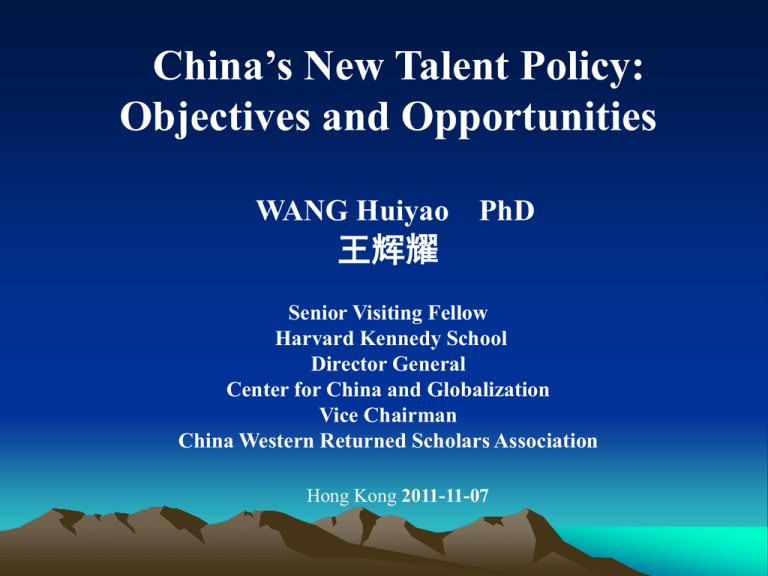PowerPoint
advertisement

China’s New Talent Policy: Objectives and Opportunities WANG Huiyao PhD 王辉耀 Senior Visiting Fellow Harvard Kennedy School Director General Center for China and Globalization Vice Chairman China Western Returned Scholars Association Hong Kong 2011-11-07 Brief CV of Dr. Huiyao Wang Dr. Wang is a Senior Visiting Fellow at Harvard Kennedy School and was a Visiting Fellow at Brookings Institution. He has taught at Peking University, Tsinghua University in China and University of Western Ontario in Canada. He has been a senior advisor to the Chinese government at both central and local levels and has served as a Task Force Leader for Global Talents Strategy Study Group of Department of Organization of Central Government. He is the Vice Chairman of China Talent Research Society of Ministry of Human Resources and also an Economic Team Leader for Overseas Experts Advisory Committee of China State Council Overseas Chinese Affairs Office. Dr. Wang has researched extensively on China’s talent issues and published over 20 books and 100 papers and articles on the subject, including his recent book National Strategy--Talents Change World and his latest English book Entrepreneurial and Business Elites of China: The Chinese Returnees Who Have Shaped Modern China. Dr. Wang has BA from China, an MBA from Canada and obtained his PhD from University of Manchester in United Kingdom. I. China Major Trends Eight Transformations in China 1. From Population Dividend to Talent Dividend • 225 million migrant workers in China • Fast aging population, 168 million over 60 • Now has 98.3 million college educated • By 2020, college educated 195 million I. China Major Trends Eight Transformations in China 2. From “Made in China” to “Created in China” • Made in China, no major branding • Labor costs on the rising side and labor unrest • High environmental and resources costs • Government goal to change China into an innovative and creative country by 2020 I. China Major Trends Eight Transformations in China 3. From Attracting Financial Capital to Attracting Human Capital • Top FDI recipient countries in the world • Largest foreign exchange reserve about USD 3 trillion. • China has 1.92 million students went overseas since 1978. As of today, only 600,000 have returned to China. • The Science and Engineering PhD graduates returned to China from US is only 8% I. China Major Trends Eight Transformations in China 4. From Hardware to Software • China has built impressive hardware: from Three Gorges Dam to super high speed railways, from Olympic Stadium to World Expo pavilions etc.. • China lacks investment in education, R&D, public health, energy conservation and environmental protection, institution building, social welfare, and many other areas related attaining balanced development. I. China Major Trends Eight Transformations in China 5. From Investment-Driven Economy to Talent-Driven Economy • China’s service sector only 42% GDP • China needs to create better paid jobs in the service sector and better use all the college graduates and talents • This helps to raise overall consumption levels and rely less on export I. China Major Trends Eight Transformations in China 6. From Resources Driven Economy to Knowledge-Driven Economy Other countries and region service sector in relation to GDP • USA 76.9% • France 78.9% • Japan 76.5% • India 54.9% • Hong Kong 95% I. China Major Trends Eight Transformations in China 7. From emphasis on Science & Technology Innovation to both S & T and Social Innovation More emphasis should be given to: • Innovation in social structure, public policy social culture, non governmental and non profitable organizations and independent think tanks • This will need more innovative talents I. China Major Trends Eight Transformations in China 8. From rely on domestic talents to rely on both domestic and international talents I. China Major Trends Eight Transformations in China 8. From rely on domestic talents to rely on both domestic and international talents Source:CPST ANALYSIS OF SED, 2006 I. China Major Trends Eight Transformations in China 8. From rely on domestic talents to rely on both domestic and international talents Source:CPST ANALYSIS OF SED, 2006 I. China MajorTrends Eight Transformations in China 8. From rely on domestic talents to rely on both domestic and international talents However, the returnees entrepreneurs going back to China are having a different picture: • I have co-authored a new study with Vivek Wadhwa, Sonali Jain, AnnaLee Saxenian, Gary Gereffi on Chinese and Indian returnee entrepreneurs and released by Kauffman Foundation in April 2011. • This study has been widely reported by many well known main stream media such as Wall Street Journal, USA Today, Business Week, China News Agency, Indian Times, etc. I. China Major Trends Eight Transformations in China 8. From rely on domestic talents to rely on both domestic and international talents ● ● ● ● ● Our survey’s key findings include: More than 60% of Indian and 90% of Chinese respondents cited economic opportunities in their countries as a very important factor in motivating the return home. The returnees took pride in contributing to economic development in their home countries. More than 60% of Indians and 51% of Chinese rated this as very important. 56% of Indians and 59% of Chinese said their quality of life back home was better or equal to what they had experienced in the United States. In China, 76% ranked access to local markets as very important. In India, 64% did. Salaries were the only advantage the respondents attributed to the United States. 64% of the Indian respondents said their salaries were better in the United States than at home. 53% of Chinese respondents said that salaries were higher in the United States, while 20% stated they were about the same in the United States and China. II. Development Review of China’s New Talent Policy • 2001 APEC conference on human capacity building in Beijing. • 2002 National Talent Building Plan • 2003 national conference on human resources development • Establishment The Central Talent Work Coordinating Group • 2007 CCP adopted talent development as a strategy to revitalize the country and put this into the Party Congress Report and Party Charter II. Development Review of China’s Talent Policy • 2008 Li Yuanchao became a CCP Politburo member and Minister of the Organization Department, place talent planning at the top of the working agenda . • 42 reports and 161 sub-reports on drafting • over 500 meetings, involve over 30,000 people nationwdie,1051 comments received. • In the end, the plan was approved by all of the top leaders in April 2010. III. Passing of China’s National Talent Development Plan (2010-2020) IV. Main Indicators of China’s Talent Plan Main Indicators of China National Talent Development Plan Target Total No. of Talent Ratio of R & D talent in Labor Force Unit Ten Thousand Person/10000 2008 2015 2020 11385 15625 18025 24.8 33 43 Ratio of High Skilled Talents in Labor Force % 24.4 27 28 Ratio of Labor Force who Have Higher Education % 9.2 15 20 Ratio of Human Capital Investment of GDP % 10.75 13 15 V. Objectives and Opportunities of China’s Talent Plan 1. Establish National Talent Development Targets • The objective of the plan is to transform China with the largest population into a stronger human resources country. • Overall talent pool will increase 114 million people to 180 million by 2020. • To increase the ratio of citizens with college education in the work force from 9.2 percent in 2008 to 20 percent by 2020. V. Objectives and Opportunities of China’s Talent Plan 1. Establish National Talent Development Targets • The objective of the plan is to transform China with the largest population into a stronger human resources country. • Overall talent pool will increase 114 million people to 180 million by 2020. • To increase the ratio of citizens with college education in the work force from 9.2 percent in 2008 to 20 percent by 2020. V. Objectives and Opportunities of China’s Talent Plan 2. Six Categories of Talent Emphasized The plan lists six major categories of talent that the government will help cultivate: • • • • • • 1) Political leaders and officials; 2) Business entrepreneurs; 3) Technical professionals; 4) Highly-skilled talents; 5) Practical talents for rural areas and agriculture; and 6) Professional social workers. V. Objectives and Opportunities of China’s Talent Plan 3. Emphasis on the Quality and Selection Process for Officials • By 2020; more than 85 percent of all government officials will have four years of college education. • The plan calls to break away from restriction and limitation from Chinese government entities and work units on talent flows and create an open environment for utilizing talented individuals. • The government must widen various channels to recruit talented individuals and improve the system that officials can be chosen and hired from various enterprises, institutions and social organization V. Objectives and Opportunities of China’s Talent Plan 4. Specific Sectors in which Talent in Great Need • By 2020, more than 5 million talented individuals will be needed in equipment manufacturing, information technology, biotechnology, new materials, aeronautics and astronautics, oceanography, finance and accounting, international business, environmental protection, energy resources, agricultural technology, and modern traffic and transportation. • In the coming 10 years, more than 8 million professionals will be needed in the fields of education, political science and law, medicine and health, publicity and cultural information, and disaster prevention. • More college graduates to work in China's rural areas to help local farmers live a better life. • Will put measures in place to train about 3 million professional social workers by 2020. V. Objectives and Opportunities of China’s Talent Plan 5. Program Support for more Talented Cultural and Scholar Figures • In order to increase China’s soft power, the plan wants to cultivate a group of highly-respected and talented scholars and cultural figures with wide influence. • Support research fields such as philosophy, social science, news and publishing, culture and art, heritage protection and related social and humanities areas. • By 2020, the number of these highly respected and very talented cultural and scholar figures funded by government can reach 2,000 people in the country. V. Objectives and Opportunities of China’s Talent Plan 6. Prioritized R&D Sectors • R&D professionals will number 3.8 million by 2020. ( EuroStats put Germany 284,3 00, France 211,100, United Kingdom 175,500, whereas US Department of Labor Statistics Bureau has put this number in the US at 621,700) • China’s national R & D spending will increase from 1.62 percent now to 2.5 percent by 2020. • China national education budget will be increased to 4 percent of GDP by 2012. V. Objectives and Opportunities of China’s Talent Plan 7. Business and Entrepreneurial Talents • The plan even sets a target for cultivating around 100 business leaders and CEOs who can lead Chinese firms getting into the rank of Fortune 500 companies by 2020. • It also sets the number of international business-savvy talents working for SOEs reach 40,000 people by 2020, with 50% of them hired through market competition. • China will recruit globally for some key top positions of large SOEs • Chinese citizenship is no longer required in hiring for some of top management positions for China’s major SOEs. • The recent high profile recruitment of Zhang Hongli from his position as the chairman of Deutsche Bank - China to the position of Vice President of the Industrial and Commercial Bank of China (ICBC), the largest bank in China. V. Objectives and Opportunities of China’s Talent Plan 8. Thousand Talents Programs • The Thousand Talents Program calls for China to attract 2,000 highlevel overseas talents to work in China in the next five-to-ten years. By the August of 2011, 1510 people had been recruited under the program, and over 70 percent of them are foreign nationals, with most of them originally from China. 300 of them have been enrolled in training courses given by various ministers, including Minister Li Yuanchao, at the Central Party School in Beijing. • The Youth Thousand Program to attract another 2000 talents under 40 years old in five years time. • The Foreign Experts Thousands Talents Plan to attract 500-1000 non Chinese experts in five years time. • China also attracts many foreign experts to come to work in China on short-term basis, 480,000/times of them from overseas to work in China in 2009. Will soon launch Foreign Experts Thousand Talent Program. V. Objectives and Opportunities of China’s Talent Plan On July 29,2010 Chinese Vice President Xi Jinping met representatives of Thousand Talent Program and welcome them at Beidaihe Summer Resort near Beijing. V. Objectives and Opportunities of China’s Talent Plan China’s other programs on overseas talents • • • • Started 1998, Changjiang Scholars Program, (长江学者计划)14000 scholars awarded for making services to over 130 universities in China Started 1997,Spring Light Program, (春晖计划) 12000 returned on short term basis for the service Started 1994, Hundred Person Program by Chinese Science Academy (百人计划) There are also 150 returnee entrepreneurial parks (创业园)set up in China and over 10000 enterprises set up by returnees V. Objectives and Opportunities of China’s Talent Plan 9. More Liberal Policy on Foreign Talents and Talent Exchanges • The plan indicates that Chinese government wants to improve its permanent foreign resident (Green Card) system. • The plan has stated that it will explore the adoption of the policy as regards technically skilled immigrants to China. • By 2009, there were only 223,000 foreigners working in China with employment permits. • The plan even calls for more foreign students to study in China. • The plan also encourages more Chinese talents to work for international institutions. Good examples of these include Justin Lin, who now is World Bank Chief Economist, and Zhu Min, now a special advisor to the IMF. By the end of 2009, there were 1,002 Chinese working in different international organizations. V. Objectives and Opportunities of China’s Talent Plan 10. Set up Special Talent Policy Management and Reform Zones • The plan also encourages local governments to set up special talent policy management and reform zones that will be compatible and connected to the international practice on talent and human resources management system. • Since the plan announced in June, now government in Beijing, Shenzhen, Wuhan, Dalian, Suzhou and Wuxi have all started to set up special talent zones in China. • Such as Wuxi has attracted over 1000 overseas startups in hi-tech, new energy, biotechnology, information and content networking. • Now Wuxi has even started a special policy to attract foreign entrepreneurs and foreign talented individuals to come to Wuxi to directly set up ventures and enterprises. VI. Implications and Impact Talent as a National Strategy to Transform China • The plan sets a new national strategy to transform China from labor-intensive country into a talent rich one by 2020. • Cheap labor has fueled China’s development over the past three decades, but that model, laden mainly with manufacturing, high resources and energy consumption and heavy pollution on environment has led China to a crossroad. • China’s talent plan has found a new growth engine and a new effective stimulus to build China into an innovative and sustainable country, but there still remains major challenges ahead, such as education reform. • While China’s past success was built mainly on its population dividend and investment, its future growth will rely more on the new talent strategy by better utilizing talents in China and attracting talents from all over the world. • Final Thoughts National Strategy, Talent Change World By Wang Huiyao, People’s Publishing Press, Beijing, China, 2010 National Strategy, Talent Change China The End Thank you ! 王辉耀 Wang, Huiyao PhD Senior Visiting Fellow Harvard Kennedy School Email: huiyao_wang@hks.harvard.edu Director General Center for China and Globalization Web: www.ccg.org.cn Email: wanghuiyao@ccg.org.cn Tel: 86-10-58205638/39, 86-13901177520








